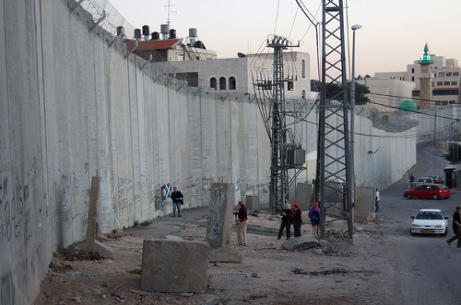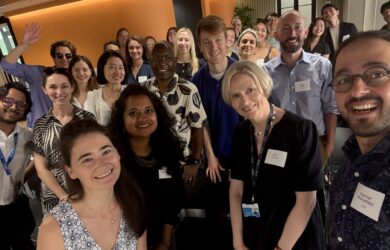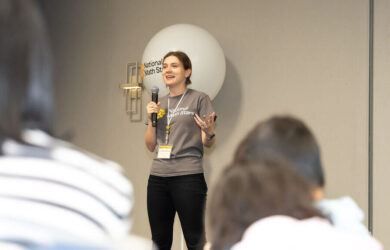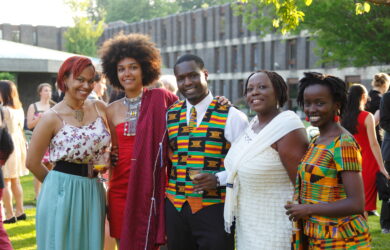
Gates Scholar Elect Hanna Baumann is fascinated by how people in highly politicised places such as Israel and Palestine negotiate shared urban spaces in their day to day lives.
Can culture act as a bridge to connect groups who are in conflict? How do divided cities operate on a day to day basis? And how do people negotiate contested spaces in cities as politicised as Jerusalem?
Hanna Baumann [2012] has been fascinated by the subject of divided cities since she was young. Her PhD in Architecture will build on her undergraduate and Master’s research, which focused on the Israeli/Palestinian conflict as well as on work she has been doing in for the United Nations on minority cultural rights in conflict affected areas.
Hanna showed an early interest in the intersection between culture and conflict. Growing up in what was then East Berlin, she was five when the Berlin Wall fell. “In some ways, it was a formative experience,” she says, “and was part of my interest in divided cities. Even after the Wall came down I could see the long-term effects on family and friends.”
As an undergraduate at Barnard College, Columbia University, she completed a dual major in Art History and the History of the Middle East. Her thesis on Art History dealt with conflict and the exclusion of marginalised groups in the shaping of public space in recently reunified Berlin. In her thesis on Middle Eastern history, she explored the conceptualisation of landscape in the history of the Israeli-Palestinian conflict. “I was interested in the point where art and politics intersect,” she says.
Although she had already pursued photojournalism at the Columbia Daily Spectator and as a freelance photographer, Hanna first considered using documentary photography as a political art form during a semester of study abroad at the American University in Cairo. While volunteering as an English teacher for refugees in Egypt, she came into close contact with displaced people from various parts of Africa and the Middle East. She set out to record her students’ personal histories in a documentary project that aimed to create a better understanding of how people become refugees. For this project, which was funded by the Centennial Scholars programme at Barnard, she visited other areas of the Middle East including Jerusalem. In this divided city – which called to mind her native Berlin – she was struck by how the ethno-national struggle impacted the urban landscape. “I could feel the tension in the streets of the old city, where Jews and Muslims uneasily shared spaces holy to both groups,” she says.
After graduating from Barnard, Hanna returned to the Middle East to work with Iraqi refugees in Jordan through the UNHCR. She then joined the humanitarian organisation ACTED in Jerusalem, working on agriculture, shelter and food security projects. She says it was striking to see how in the Israel-Palestine context even seemingly innocuous activities like agriculture were deeply intertwined with questions of belonging and ownership. So, when she won a Mortimer Hayes-Brandeis Travelling Fellowship, which financed a year-long photography project, she chose to focus on the meaning of land and agriculture to both Israelis and Palestinians.
From there, she applied for a Master’s in Refugee and Forced Migration Studies at Oxford University, focusing specifically on Jerusalem and once again on the intersection of art, history and politics. She was particularly interested in the politicisation of archaeology in the Old City of Jerusalem and its surrounding areas, where some of the archaeological work threatens local residents with displacement. “Next to this physical effect of archaeology, the implications of the excavations are also highly political – touching on questions of who was here first and who this land belongs to,” she says. “It’s the combination of those two aspects, the physical and the metaphysical, that interested me.” Following her course at Oxford, Hanna stayed engaged in refugee issues as an editor of the newly founded student-run journal Oxford Monitor of Forced Migration.
She then won a Mercator Fellowship on International Affairs, which allowed her to follow her research interests for a year while working with international organisations. She chose UNESCO and the Office of the High Commissioner for Human Rights (OHCHR). “I wanted to broaden my knowledge and put it into a different practical and geographical context. After all, urban displacement and inequality exists in many contexts,” says Hanna.
She worked as Programme Officer in UNESCO’s New Delhi office, dealing primarily with the preservation of urban heritage and minority rights in the context of India’s ever-growing cities and then became UNESCO’s consultant for culture in Sri Lanka. “I was interested in working on a post-conflict situation,” she says. She has been monitoring cultural rights in conflict-affected areas in the North and East of the country, looking at what people consider as their joint heritage. “Ideally we want to use culture as a means of reconciliation, as a bridge to connect different groups,” she says.
In addition, at OHCHR, Hanna has been working as a consultant for the UN Special Rapporteur on Cultural Rights and the Special Rapporteur on the Right to Adequate Housing, applying the issues that interest her in the Middle East and South Asia in other country contexts. She also became Editor-in-Chief of the programme’s German-language magazine on international politics, ad hoc international.
For her PhD in Architecture at Cambridge, which she begins in the autumn, she will return to the conflict in Israel and Palestine and study how Jerusalem’s residents participate in shaping urban space in the city. Working with Dr Wendy Pullan, who leads the Conflict in Cities and the Contested State research project, she plans to investigate how people negotiate space in Jerusalem. “I am interested in highlighting the agency of marginalised groups,” she says. “How do they demarcate their areas? How do they use the spaces they inhabit and navigate on a daily basis? What are their daily routines and coping mechanisms in a city that is so divided by conflict?”
Picture credit: Creative Commons and delayed gratification.












